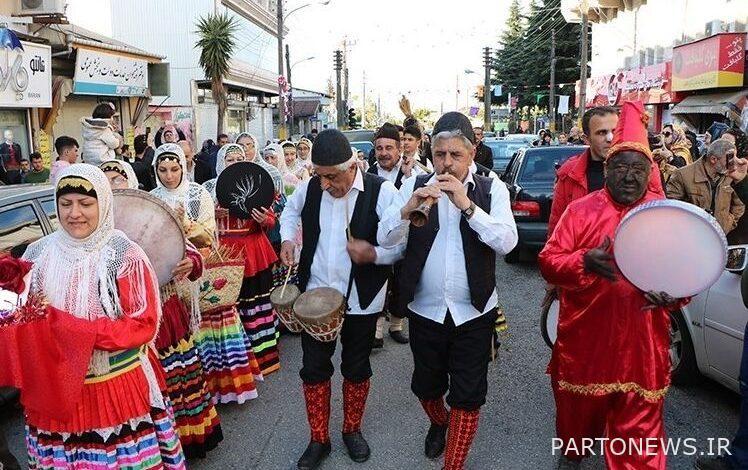Nowruz greeting with Chavosh readers of Guilan spring

Nowruz recitation is an ancient ritual of the ancestors of Gilani, in which the Chavosh singers of spring sing Nowruz a few days before Nowruz with poetry, instruments and tarb, and take the good news of spring from the people of their land. Celebrating Nowruz has a special tradition in every corner of Iran. The culture of every nation is a combination of beliefs, beliefs, myths, rituals, ceremonies and in general ways and patterns of life that have been created and studied by our ancestors and ancestors throughout history. And during the process of socialization, it is transmitted from one generation to another and causes the continuation and maintenance of social and cultural patterns in society.
Also, the culture of the people of Gilan, like all oral and popular cultures, has been formed over time and from mythical and religious elements, and religious performances are an integral part of this culture.
Nowruz, a ritual for revival and credit for thousands of years on the eve of Nowruz, the song of Nowruz singers is getting closer every moment and they sing: Spring has come, spring has come, all flowers are blossoming / On every flower branch, a nightingale is sitting / Happy Badton, Happy New Year / by the sanctity of Surah Tabarak…
Gilan has an ancient history full of mirrors and ceremonies, each of which is performed in its season, time and place, and each is an indicator of ancient culture. And Nowruz recitation is an ancient ritual that celebrates the good news of spring, and now the head of the General Directorate of Heritage, Culture, Tourism and Handicrafts of Gilan, along with emphasizing the observance of health procedures, said: Nowruz recitation is held throughout the province.
New Year greeting
Mohammad Bashra, one of the researchers and celebrities of Gilan, says in the book Encyclopedia of Culture and Civilization of Gilan: Myths, celebrations and ancient rituals of ancient Iran in Gilan are influenced by the natural, geographical, historical and living conditions of this land for survival in terms of structure, type of narrative And even popular beliefs have embraced change.
He also writes about the Nowruz celebration in Gilan: This ceremony is held between the time of old and new times; When the old era is coming to an end and the new era is ahead with the rebirth and revival of nature.
The researcher of rituals and cultures of Gilan, continues: About 15 to 20 days before the New Year, the celebration of Nowruz begins, houses, shops and streets are demolished and cleaned, and lentil and wheat grains They soak and grow in containers.
Bashra adds: Nowruz celebrations are often allegorical and are related to the rebirth of nature. The people of Gilan also celebrate Nowruz with dramatic rituals such as Goli bride, Rabarchereh, Nowruz reading, Chaharshanbeh Soori and shawl-making.
He considers Nowruz recitation as a kind of informing people about spring and Nowruz and says: Nowruz reciters were well-known and a handful of literate villagers, and in each Nowruz recitation group, an older person recited the main poems of Nowruz and the others repeated… Spring came Let the youth see good / Let the flowers of Ishrat be in your heart / Let your youth be the bridegroom / The brides of the cradle of the child / To Yasin and Taha and Tabarak / Happy New Year to you.
He considers ritual performances such as the flower bride (war between winter and spring with the symbol of the giant and the bride) and Rabarchereh (the deer herder) in its simplest form as a symbol of the return or approach of the sun to the tower and the vernal equinox and resurrection of life. .
Bashra says: Nowruz table bread was mostly made of Komach, Keshta or Khulfa bread (bread prepared from squash), rice bread that was all baked from rice flour and Nowruz nuts were never bought from the market and its components were eggs. Summer was cob seeds, peas, lentils and rice that were roasted after soaking.
He considers happiness and joy to be the most important characteristic of people in Nowruz.
Celebrities with Nowruz guests
Ancient Gilan, the land of rain and the culture of its heroes, are still as strong and steadfast as its millennial Hyrcanians, and one by one they have overshadowed the country and the world. How little do they know about their homeland, but in another news, the head of the General Directorate of Heritage, Culture, Tourism and Handicrafts of Gilan informed Nowruz that he benefited from the presence of Gilani celebrities along with Nowruz guests in the province’s historical and tourist sites during the 1401 Nowruz holiday.
Referring to the implementation of this project for the first time in Gilan province, Jahani said: with the presence of Gilan province celebrities in the historical and tourist sites of Gilan province, the rich cultural resources and civilization of the people of different parts of the province will be properly introduced to tourists.
Referring to the advantages of the presence of Gilani celebrities, Jahani added: Gilan province has valuable cultural, scientific and historical capacities and it is necessary to use this rich treasure to set a model for the new generation by implementing well-written programs while introducing these resources purposefully.
Gilan is not only the land of color and nature, and it is possible that in every period, celebrities have emerged from it who have left a deep and effective trace on the cultural history of Iran and the world, and the name of Gilan has been associated with culture since ancient times.
The green land of Gilan is the land of rice and rain, forest and color, fish and sea without any exaggeration and because of its ancient richness, it is full of rituals and cultures that alone can be the origin of the culture of lovers who want to travel to know it. They submit.

